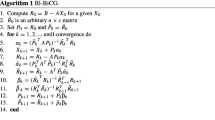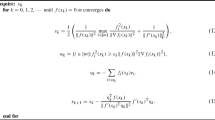Abstract
Many iterative methods for solving linear equationsAx=b aim for accurate approximations tox, and they do so by updating residuals iteratively. In finite precision arithmetic, these computed residuals may be inaccurate, that is, they may differ significantly from the (true) residuals that correspond to the computed approximations. In this paper we will propose variants on Neumaier's strategy, originally proposed for CGS, and explain its success. In particular, we will propose a more restrictive strategy for accumulating groups of updates for updating the residual and the approximation, and we will show that this may improve the accuracy significantly, while maintaining speed of convergence. This approach avoids restarts and allows for more reliable stopping criteria. We will discuss updating conditions and strategies that are efficient, lead to accurate residuals, and are easy to implement. For CGS and Bi-CG these strategies are particularly attractive, but they may also be used to improve Bi-CGSTAB, BiCGstab(l), as well as other methods.
Zusammenfassung
Viele iterative Methoden zur Lösung linearer Gleichungssysteme berechnen die Iterierten über aufdatierte Residuen. In endlicher Arithmetik können diese Residuen sehr ungenau sein, d.h., sie können sich erheblich von den tatsächlichen unterscheiden. In dieser Arbeit stellen wir Varianten der Neumaier Strategie vor, die ursprünglich für das CGS-Verfahren vorgeschlagen wurde, und erklären deren Erfolge. Insbesondere werden wir eine Variante vorschlagen, bei der mehrere Aufdatierungsschritte zusammengefaßt werden. Wir zeigen, daß sich die Genauigkeit der berechneten Residuen dadurch erheblich verbessern läßt, ohne daß die Konvergenzgeschwindigkeit beeinträchtigt wird. Dieser Ansatz vermeidet Neustarts und ermöglicht zuverlässigere Abbruchkriterien. Wir diskutieren Aufdatierungsbedingungen und Strategien, die effizient und leicht zu implementieren sind. Diese Strategien führen zu genaueren Residuen und sind insbesondere für CGS und Bi-CG-aber auch für Bi-CGSTAB, BiCGstab(l) und andere Verfahren-sehr attraktiv.
Similar content being viewed by others
Explore related subjects
Discover the latest articles, news and stories from top researchers in related subjects.References
Bai, Z.: Error analysis of the Lanczos algorithm for the nonsymmetric eigenvalue problem. Math. Comp.62, 209–226 (1994).
Fletcher, R.: Conjugate gradient methods for indefinite systems. In: Proc. of the Dundee Biennial Conference on Numerical Analysis (Watson, G., ed.), pp. 73–89. New York: Springer 1975.
Fokkema, D. R., Sleijpen, G. L. G., van der Vorst, H. A.: Generalized conjugate gradient squared. Preprint 851, Dept. Math., University Utrecht (1994).
Freund, R. W.: A transpose-free quasi-minimal residual algorithm for non-Hermitian linear systems, SIAM J. Sci. Comput.14, 470–482 (1993).
Freund, R. W., Gutknecht, M. H., Nachtigal, N. M.: An implementation of the look-ahead Lanczos algorithm for non-Hermitian matrices. SIAM J. Sci. Comput.14, 137–158 (1993).
Freund, R. W., Nachtigal, N. M.: QMR: a quasi-minimal residual method for non-Hermitian linear systems. Numer. Math.60, 315–339 (1991).
Greenbaum, A.: Behavior of slightly perturbed Lanczos and conjugate gradient recurrences. Linear Algebra Appl.113, 7–63 (1989).
Greenbaum, A.: Estimating the attainable accuracy of recursively computed residual methods. Preprint, Courant Institute of Math. Sc., 1995.
Lanczos, C.: Solution of systems of linear equations by minimized iteration. J. Res. Nat. Bur. Stand.49, 33–53 (1952).
Meier Yang, U.: Preconditioned conjugate gradient-like methods of nonsymmetric linear systems. Preprint, Center for Research and Development, University of Illinois at Urbana-Champaign, 1992.
Neumaier, A.: Oral presentation at the Oberwolfach meeting “Numerical Linear Algebra”. Oberwolfach, April 1994.
Paige, C. C.: Accuracy and effectiveness of the Lanczos algorithm for the symmetric eigenproblem. Linear Algebra Appl.34, 235–258 (1980).
Paige, C. C., Parlett, B. N., Van der Vorst, H. A.: Approximate solutions and eigenvalue bounds from Krylov subspaces. Numer. Lin. Agl. Appl.2, 115–134 (1995).
Saad, Y.: A flexible inner-outer preconditioned GMRES algorithm. SIAM J. Sci. Statist. Comput.14, 461–469 (1993).
Saad, Y., Schultz, M. H., GMRES: A generalized minimum residual algorithm for solving nonsymmetric linear system. SIAM J. Sci. Stat. Comp.7, 856–869 (1986).
Sleijpen, G. L. G., Fokkema, D. R.: BiCGstab(l) for linear equations involving matrices with complex spectrum. Elect. Trans. Numer. Anal. (ETNA)1, 11–32 (1993).
Sleijpen, G. L. G., Van der Vorst, H. A. Maintaining convergence properties of BiCGstab methods in finite precision arithmetic. Preprint Nr. 861, Dept. Math., University Utrecht, 1994. To appear in Numerical Algorithms.
Sleijpen, G. L. G., Van der Vorst, H. A., Fokkema, D. R.: BiCGstab(l) and other hybrid Bi-CG methods. Numer. Alg.7, 75–109 (1994).
Sonneveld, P.: CGS, a fast Lanczos-type solver for nonsymmetric linear systems. SIAM J. Sci. Stat. Comp.10, 36–52 (1989).
Van der Vorst, H. A.: Bi-CGSTAB: A fast and smoothly converging variant of Bi-CG for the solution of nonsymmetric linear systems. SIAM J. Sci. Stat. Comput.13, 631–644 (1992).
Zhou, L., Walker, H. F.: Residual smoothing techniques for iterative methods. SIAM J. Sci. Comput.15, 297–312 (1994).
Author information
Authors and Affiliations
Rights and permissions
About this article
Cite this article
Sleijpen, G.L.G., van der Vorst, H.A. Reliable updated residuals in hybrid Bi-CG methods. Computing 56, 141–163 (1996). https://doi.org/10.1007/BF02309342
Received:
Revised:
Issue Date:
DOI: https://doi.org/10.1007/BF02309342




